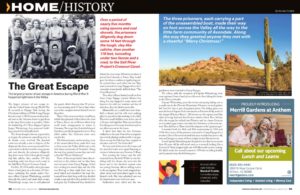The Great Escape: The largest prisoner of war escape in America during World War II happened right here in the Valley
The largest prisoner of war escape in America during World War II happened right here in the Valley.
By Marshall Trimble
The largest prisoner of war escape inside the United States during World War II occurred at Papago Park during the Christmas holidays of 1944. Camp Papago housed some 1,700 German naval personnel sent to the Arizona desert to get them as far away from water as possible. Under the leadership of U-Boat skipper Captain Jurgen Wattenberg, they proposed building a faustball (volleyball court).
The Army thought this was a great idea, as it gave the prisoners something else to do beside cause mischief. The faustball court was actually a ruse to dispose of the displaced dirt from an escape tunnel. Over a period of nearly five months using spoons and coal shovels, the prisoners diligently dug down some 14 feet through the tough, clay-like caliche, then another 178 feet, tunneling under two fences and a road, to the Salt River Project’s Crosscut Canal.
On Dec. 23, 1944, while other prisoners threw a loud party as a diversion, 25 Germans, including the camp’s senior German officer Captain Wattenberg, crawled through the tunnel and made their escape. Wattenberg’s escape was so well-planned the guards didn’t discover that 25 prisoners were missing until 17 hours later when one of the escapees turned himself over to the police.
Three of the prisoners built a small boat, which they planned to float down the river to Yuma, thence on to Mexico where they could make arrangements to return to Germany. The maps they’d studied showed blue lines, usually designated as rivers. They didn’t realize that Arizona’s rivers were usually dry.
The three prisoners, each carrying a part of the unassembled boat, made their way on foot across the Valley all the way to the little farm community of Avondale. Along the way they greeted anyone they met with a cheerful “Merry Christmas!”
News of the escape hadn’t been discovered yet so the citizens had no idea these were escapees from Camp Papago. It had been raining for several days and the Gila was flowing so they made their way to a small island and assembled the boat. Exhausted from their long walk they decided to take a nap and when they awoke the river had gone dry. Undaunted they decided to follow the river some 200 miles to where it joined the Colorado at Yuma. They hadn’t gone far when a cowboy out gathering cattle spotted them and called the law. They were returned to Camp Papago where their comrades immediately dubbed them “The Crazy Boatmen.”
Two other officers headed south on foot from Camp Papago towards Mexico but along the way stepped in some cactus and between the cold, wet weather and fear of infection, they decided to surrender.
Meanwhile, on a small farm near Stanfield, a farmer and his wife were making plans to spend the day working in the field. Their two small children were in the care of a 16-year-old neighbor. They warned them that dangerous Germans were loose and to not allow anyone in the house.
A short time later the two Germans walked in to the yard. One of the youngsters was outside playing cowboys with a toy gun. Upon seeing the little boy, they snapped to attention and said “Vee Surrender!”
The boy invited them into the house and the next few hours were spent listening to stories of adventures on a German U-Boat.
That evening the farmer and his wife returned from the field. While he was finishing with the chores, she went into the house and to her shocked surprise were two young German officers telling stories to the youngsters. They stood, snapped another salute and surrendered again to the farmer’s wife. She later admitted one was the handsomest man she’d ever seen.
Authorities were called and the two gentlemen were returned to Camp Papago.
The others, with the exception of Captain Wattenberg, were soon captured. Some found prison life easier than hiking the desert to the Mexican border.
Captain Wattenberg spent the winter and spring hiding out in a small cave in the Phoenix Mountains. Prisoners on work parties left food for him in pre-designated places. His hiding place was near the foot of Squaw Peak now known as Piestewa Peak, north of the elegant Biltmore Resort. Old timers say the captain could lay claim to being Arizona’s first German winter visitor. Then 36 days after the escape, he walked into Phoenix and in a heavy German accent asked a gas station attendant for directions to the train station. That did him in. Thus closed the chapter on the “great escape.”
I attended both the 40th and 50th anniversaries in 1984 and 1994 when many of the prisoners returned to Camp Papago for a reunion. One of them mentioned that once outside they were cold, wet, and hungry so many of them simply turned themselves in.
I met Captain Wattenberg and despite the fact that he was more than 80 years old he still stood erect as a ramrod, looking like a German U-Boat skipper right out of Hollywood’s central casting. He didn’t make the second re-union in 1994 due to failing health, passing away the following year.
Related posts
Leave a Comment
You must be logged in to post a comment.







